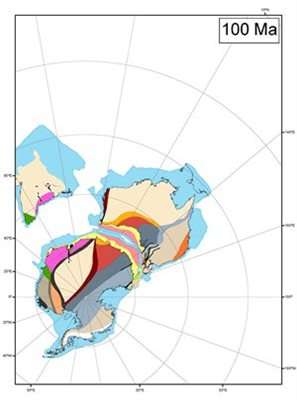Study reveals ancient jigsaw puzzle of past supercontinent

A new study published today in the journal Gondwana Research, has revealed the past position of the Australian, Antarctic and Indian tectonic plates, demonstrating how they formed the supercontinent Gondwana 165 million years ago.
Researchers from Royal Holloway University, The Australian National University and Geoscience Australia, have helped clear up previous uncertainties on how the plates evolved and where they should be positioned when drawing up a picture of the past.
Dr Lloyd White from the Department of Earth Sciences at Royal Holloway University said: "The Earth's tectonic plates move around through time. As these movements occur over many millions of years, it has previously been difficult to produce accurate maps of where the continents were in the past.
"We used a computer program to move geological maps of Australia, India and Antarctica back through time and built a 'jigsaw puzzle' of the supercontinent Gondwana. During the process, we found that many existing studies had positioned the plates in the wrong place because the geological units did not align on each plate."
The researchers adopted an old technique used by people who discovered the theories of continental drift and plate tectonics, but which had largely been ignored by many modern scientists.
This video shows a reconstruction of the breakup of the Australian, Antarctic and Indian tectonic plates, demonstrating how the major plates that once formed eastern Gondwana broke apart, starting from 165 millions years ago and progressing to the present day. The coloured polygons represent different geological units that have been mapped (and inferred) by geologists over many years. These geological units formed before the continents broke apart, so we can use their position to put the "jigsaw pieces" back together again. Many other reconstructions do not use the geological boundaries to match the continental "jigsaw pieces" back together - so they don't align properly. This is discussed in detail in a scientific paper titled: "A reassessment of paleogeographic reconstructions of eastern Gondwana: bringing geology back into the equation" which is published in the journal "Gondwana Research".
"It was a simple technique, matching the geological boundaries on each plate. The geological units formed before the continents broke apart, so we used their position to put this ancient jigsaw puzzle back together again," Dr White added.
"It is important that we know where the plates existed many millions of years ago, and how they broke apart, as the regions where plates break are often where we find major oil and gas deposits, such as those that are found along Australia's southern margin."
More information: www.sciencedirect.com/science/ … ii/S1342937X1300213X
Provided by Royal Holloway, University of London





















